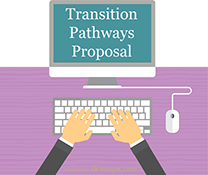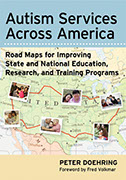Create a foundation for collective impact
November 2, 2016
 The principles of collective impact - common agenda, continuous communication, mutually reinforcing actions, shared measurement, and a common backbone - were a natural fit given the project's structure and goals. The lessons I had learned earlier in my career regarding the benefits - and the challenges - of building collaborative networks, and more recent work with the National Autism Leadership Collaborative to develop detailed rubrics for tracking collective impact, were other key reference points.
The principles of collective impact - common agenda, continuous communication, mutually reinforcing actions, shared measurement, and a common backbone - were a natural fit given the project's structure and goals. The lessons I had learned earlier in my career regarding the benefits - and the challenges - of building collaborative networks, and more recent work with the National Autism Leadership Collaborative to develop detailed rubrics for tracking collective impact, were other key reference points.
Why consider a collective impact approach?
Many universities and hospitals that obtain start up funds through grants and gifts move quickly to create a new center, seeking to brand themselves as the regional “expert”. This approach can discount invaluable expertise in existing, community-based agencies, and creates a wholly unrealistic expectation that a single entity can meet the needs of a region. Instead of seeking to create a single entity that would address all service needs, we saw an opportunity to foster collaboration across multiple agencies that has the real potential to build regional capacity. This built on lessons I learned early in my career about the impact of regional collaboratives.
I have also found that this need for a collaborative approach increases with the scope of the project. At some point in their development, many regional and statewide programs seek to integrate different elements (like services, training, research, and policy) and cross multiple domains (like education, health and community services). UCEDDS (university centers of excellence in developmental disabilities) are perhaps the only kind of program that is naturally suited to develop multi-element, cross-domain, small scale demonstration projects (Doehring, 2013).
Common Agenda
During initial conversations with potential programs, I listened carefully for barriers and opportunities shared across agencies. I used these to plant the seeds for a common agenda. What emerged through these a desire for better coordination and communication with partner agencies, improved access for underserved families, a sustainable program with the potential for growth, and the creation of employment opportunities at Drexel and with its network of co-op partners.
I have also found that the process of developing detailed program guidelines can help to establish a common agenda by anticipating areas of difficulty. I expected to solicit input from agency partners in developing these detailed program guidelines as another way to establish a consensus regarding our focus. I began by developing FAQs for those seeking more information, the first of which was made available to the public the day the gift was announced. I had more detailed FAQs in the queue, under development with partner agencies, as different phases rolled out.
Continuous communication
The need for continuous communication was evident during the development and launch phase. Whenever a new potential opportunity or barrier emerged in discussions with one partner, we needed to check the potential fit with another. Some of the most critical discussions occurred without our involvement - for example, a meeting between our champion within one agency with their own supervisor, to get permission to move ahead.
The different sets of talking points that I developed for different champions, tailored to the needs of their particular organization, were invaluable in supporting and shaping these discussions, between partners and within partner agencies. I also found that process of developing the FAQ documents described above was very helpful in answering the questions of Drexel and community partners.
Mutually reinforcing plan of action
My early and extensive conversations with potential partners revealed naturally overlapping and complementary services and training offered by across school, work, and community-based activities. For example, the school and vocational agency both sought structured internship placements, and Drexel was eager to begin to explore how to create job opportunities for those with disabilities. Overlapping and complementary programs of services and training were critical to controlling overall costs.
The task or coordinating programs across agencies for a classroom of students on a day to day basis is, however, daunting task. I have found that designating a specific staff member, a specific set of activities, and specific expectations for these shared goals, is critical to move from aspiration to implementation when coordinating across agencies. Anchoring the first year of the program in the classroom supervised by a teacher as part of the IEP was a natural solution: it provided a "home-base" for coordinating activities supported by Drexel and OVR, as part of a transition plan mandated by federal regulation and developed with input all parties (including the student). Given important lessons I had learned regarding the frequent need for care coordination, the potential for a special education teacher to coordinate individual care in the context of transition planning was very compelling. The lack of a clear home base or a naturally positioned care coordinator in the second year was more concerning, but led me to increase the focus on transition plan coordinated across agencies, and helping the young adult to take ownership of it.
Shared measurement
The “holy grail” of collective impact is the identification of goals that are clearly consistent with a better quality of life, that can be meaningfully measured across individual clients, that are developed with input from all parties, and that are carefully tracked by partner agencies to shape their efforts to improve their own program. This was a key goal when I outlined the tracks and expected outcomes to include for the program descriptions to be shared with the funder, our partners, and the public.
I was especially excited because of an earlier lesson about the potential for surveys to identify critical gaps and to set benchmarks for new programs. Could we translate the specific findings summarized in the National Autism Indicators Report into measurable goals for Drexel and our partner organizations, to the benefit of real people living with ASD right now? Could we would use our progress towards these goals to help us to establish priorities and guide the plan of action at the level of the individual student, the partner agency, and the program as a whole. I had anticipated drawing on my experience in school- and hospital-based programs to set specific goals at both the individual and the program level.
A common backbone
I viewed the proposal as funding the creation of a backbone that functions to support the development of all of the key components of collective impact as described above. Though the Autism Institute was naturally suited as a backbone for a network that included both community based agencies, and departments within and outside of Drexel, it was clear that we could not also presume to also be the brain.
Throughout initial discussions with potential partners, I was very careful not to position ourselves as the experts, but as the coordinators of the efforts of equally valued partners within and across Drexel. In this case, the key partners included a school district (the School District of Philadelphia), an adult employment and developmental services agency (CIS Works), Drexel University (acting as an employer, a community of peers, an institute of higher education, and the entity coordinating the program itself), and a variety of potential funders. Given the goals of ensuring access to underserved groups, I sought from the beginning to build the first year of the program around a close partnership with the School District of Philadelphia.
For all of our partners, we needed to understand their strengths and opportunities for improvement (level of funding, existing expertise, potential for innovation and expansion). The DREAM Partnership proved especially important in providing guidance for the College Pathway and elements of the funding model, as well as awarding up to 3 years of start-up funding of up to $180 000. In each of these cases, I anticipated developing formal memoranda of agreement describing the roles and responsibilities of the Transition Pathways team in relation to each of the partner agencies, similar to those I negotiated in Delaware.
Related Content
On this site
X
My Presentations and Publications
 (2016). Incubating programs of services and training for people with develop-mental disabilities: A new partnership for UCEDDs, community-based providers, and philanthropists. Association of University Centers on Disability, Washington, DC.
(2016). Incubating programs of services and training for people with develop-mental disabilities: A new partnership for UCEDDs, community-based providers, and philanthropists. Association of University Centers on Disability, Washington, DC.
Guideposts
![]() Straight Lines Use large, well-designed surveys to identify critical gaps in access to basic care, and to set benchmarks for new programs
Straight Lines Use large, well-designed surveys to identify critical gaps in access to basic care, and to set benchmarks for new programs
![]() Simple Steps Ensure a sustainable pipeline of participants by carefully matching programs to the unmet needs identified in the region
Simple Steps Ensure a sustainable pipeline of participants by carefully matching programs to the unmet needs identified in the region
![]() Other Lessons Collaborative networks multiply the impact of new initiatives when they carefully draw on the strengths of each partner
Other Lessons Collaborative networks multiply the impact of new initiatives when they carefully draw on the strengths of each partner










